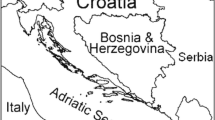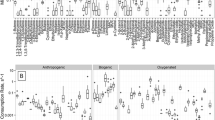Abstract
Atmospheric concentrations of ca. 250 C6–C15 hydrocarb on and C4–C12 oxygenated volatile organic compounds (VOC) including alkanes, benzene and alkyl benzenes, monoterpenes and aldehydes were measured in August 1994 during the POPCORN campaign (POPCORN = Photo-Oxidant formation by Plant emitted Compounds and OH Radicals in North-Eastern Germany). About 80 substances together contributed 90% of the atmospheric carbon in this range of molecular weight. During this field campaign VOC-emissions from several crop and tree species and the ambient concentrations of CO, C2–C7 non-methane hydrocarbons (NMHC), C1 and C2 aldehydes, nitrogen oxides, ozone and hydroxyl-radicals (OH) were also measured. These data were used to interpret the VOC measurements presented here. The on-line GC–MS used for the VOC measurements combines adsorptive sampling with thermal desorption and GC–MS analysis in an automated system. Internal standards were used to quantify the measurements. Ozone was destroyed prior to the sample preconcentration through the gas phase reaction with NO. Aromatic compounds like benzene, toluene and xylenes were the most abundant compound class among the measured substances, α-pinene and Δ3-carene, most probably originating from pineforests ca. 1 km away from the measuring site, were the most abundant monoterpenes. The highest mixing ratios of most compounds were measured in nights with strong inversion situations. The toluene mixing ratios then reached 630 pptv; α-pinene mixing ratios went up to 430 pptv. The median of all toluene and α-pinene measurements during the campaign was 125 pptv or 22 pptv, respectively. These values are on the lower end of ambient measurements reported for continental sites. In most samples also n-pentanal, n-hexananl, n-nonanal and n-undecanal were present. Median mixing ratios were 9, 16, 14 and 8 pptv, respectively. Emission studies indicate that these highly reactive compounds are most probably emitted from maize. It is shown by a simple first order approach that the potential for ozone formation during the POPCORN campaign was roughly equal for anthropogenic and biogenic VOC. From measured concentrations of ozone, OH-radicals, methane, CO, C2–C15 nonmethane hydrocarbons (NMHC) and C5–C11 aldehydes a photochemical production of ozone in the order of 3.5 ppb/h can be estimated. Apart from formaldehyde and acetaldehyde, which are at least partly products of VOC oxidation, the substance group with the largest contribution to the VOC turnover are the monoterpenes. They contribute ca. 30%. However, the mechanism of terpene oxidation is very complex and presently only partly understood. Thus the actual contribution of monoterpenes to ozone formation is very uncertain. Other measured compound classes such as light alkenes, alkanes, aromatics, and C5–C11 aldehydes contribute each between 10% and 15% to ozone formation. The measuring site was not influenced directly from strong biogenic or anthropogenic sources, and the results obtained during the POPCORN campaign can be regarded as a typical picture of a remote rural central European environment.
Similar content being viewed by others
References
Adams, R. P., 1989: Identification of Essential Oils by Ion Trap Mass Spectroscopy, Academic Press, San Diego.
Atkinson, R., Baulch, D. L., Cox, R. A., Hampson Jr., R. F., Kerr, J. A., and Troe, J., 1992: Evaluated kinetic and photochemical data for atmospheric chemistry: Supplement IV, Atmos. Environ. 26A(7), 1187-1230.
Atlas, E. L., Li, S.-M., Standley, L. J., Hewitt, R. A., Hites, C. N., and Sturges, W. T., 1993: Natural and Anthropogenic Organic Compounds in the Global Atmosphere/Global Atmospheric Chemical Change, Vol. 8, Elsevier, London and New York, pp. 313-–381.
Arey, J., Winer, A. M., Atkinson, R., Aschmann, S. M., Long, W. D., and Morrison, C. L., 1991: The emission of (Z)-3-hexen-1-ol, (Z)-3-hexenylacetate and other oxygenated hydrocarbon from agricultural plant species, Atmos. Environ. 25A, 1063-1075.
Benning, L. and Wahner, A., 1998: Measurements of atmospheric formaldehyde and acetaldehyde: Description and characterisation of the 2,4-DNPH coated silica cartridges, J. Atmos. Chem. 31, 105-117.
Brandenburger, U., Brauers, T., Dorn, H.-P., and Hausmann, M., 1998: In-situ measurement of tropospheric hydroxyl radicals by folded-long-path-laser-absorption during the field campaign POPCORN in 1994, J. Atmos. Chem. 31, 181-204.
Brauers, T., Dorn, H. P., Koch, H., Kraus, A., and Plass-Dülmer, C., 1998: Meteorological aspects, ozone and solar radiation measurements during POPCORN 1994, J. Atmos. Chem. 31, 33-52.
Calogirou, A., Larsen, B. R., Brussol, C., Duane, M., and Kotzias, D., 1996: Decomposition of terpenes by ozone during sampling on Tenax, Anal. Chem. 68, 1499-1506.
Dietz, W. A., 1967, Response factors for gas chromatographic analysis, J. Gas Chromatogr. 5, 68-71.
Fehsenfeld, F., Calvert, J., Fall, R., Goldan, P., Guenther, A. B., Hewitt, C. N., Lamb, B., Liu, S., Trainer, M., Westberg, H., and Zimmerman, P., 1992: Emissions of volatile organic compounds from vegetation and the implications for atmospheric chemistry, Global Biogeochem. Cycles 6, 389-430.
Goldan, P. D., Kuster, W. C., Fehsenfeld, F. C., and Montzka, S. A., 1995: Hydrocarbon measurements in the southeastern United States: The rural oxidants in the southern environment (ROSE) program 1990, J. Geophys. Res. 100, 25945-25963.
Graedel, T. E., Bates, T. S., Bouwman, A. F., Cunnold, D., Dignon, J., Fung, I., Jacob, D. J., Lamb, B. K., Logon, J. A., Marland, G., Middleton, P., Pacyna, J. M., Placet, M., and Veldt, C., 1993: A compilation of inventories of emissions to the atmosphere, Global Biochem. Cycles 7, 1-26.
Hewitt, C. N. and Street, R. A., 1992: A qualitative assessment of the emission of non-methane hydrocarbon compounds from the biosphere to the atmosphere in the U.K. - present knowledge and uncertainties, Atmos. Environ. 26, 3069-3077.
Hinds, W. C., 1982: Aerosol Technology, John Wiley and Sons, New York, Chichester, Brisbane, Toronto, Singapore.
Hoffmann, T., 1992: Entwicklung eines Verfahrens zur Messung luftgetragener biogener Kohlenwasserstoffe und seine Anwendung zur Untersuchung von Emission und Abbau von Terpenen in Waldbeständen, Dissertation, Universität Dortmund, Germany.
Hoffmann, T., Jacob, P., Linscheid, M., and Klockow, D., 1993: Measurements of biogenic hydrocarbons and their atmospheric degredation in forests, Intern. J. Environ. Anal. Chem. 52, 29-37.
Holland, F., Aschmutat, U., Heßling, M., Hofzumahaus, A., and Ehhalt, D. H., 1998: Highly time resolved measurements of OH during POPCORN using laser induced fluorescence spectroscopy, J. Atmos. Chem. 31, 205-225.
Hofzumahaus, A., Aschmutat, U., Brandenburger, U., Brauers, T., Dorn, H.-P., and Hausmann, M., Heßling, M., Holland, F., Plass-Dülmer, C., and Ehhalt, D. H., 1998: Intercomparison of tropospheric OH measurements by different laser techniques during the POPCORN campaign 1994, J. Atmos. Chem. 31, 227-246.
König, G., Brundla, M., Puxbaum, H., Hewitt, C. N., Duckham, S. C., and Rudolph, J., 1995: Relative cotnribution of oxygenated hydrocarbons to the total biogenic VOC emissions of selected mid-European agricultural and natural plant species, Atmos. Environ. 29, 861-874.
Koppmann, R., Johnen, F. J., Khedim, A., Rudolph, J., Wedel, A., and Wiards, B., 1995: The influence of ozone on light non-methane-hydrocarbons during cryogenic preconcentration, J. Geophys. Res. 100, 11383-11391.
Koppmann, R., Plass-Dülmer, C., Ramacher, B., and Rudolph, J., 1998: Measurements of carbon monoxide and nonmethane hydrocarbons during POPCORN, J. Atmos. Chem. 31, 53-72.
Kwok, E. S. C., and Atkinson, R., 1995: Estimation of hydroxyl radical rate constants for gas phase organic compounds using a struture-reactivity relationship: an update, Atmos. Environ. 18, 1685-1695.
Lamb, B., Gay, D., and Westberg, H., 1993: A biogenic hydrocarbon emission inventory for the U.S.A. using a simple forest canopy model, Atmos. Environ. 27A, 1673-1690.
Mallard, W. G., Westley, F., Herron, J. T., and Hampson, R. F., 1994: NIST chemical kientics database Version 6.0, NIST Standard Reference Data, Gaithersburg M.D.
Parusel, Eva, 1996: Zur Bedeutung von Pflanzen als Quelle leichter Nicht-Methan Kohlenwasserstoffe für die Atmosphäre - Entwicklung einer Feldmeßmethode und Untersuchungen an Nutzpflanzen und Gehölzen, PhD Thesis, Technische Universität Braunschweig, Germany.
Plass-Dülmer, C., Brauers, T., and Rudolph, J., 1996: POPCORN - A field study of photochemistry in north-eastern Germany, J. Atmos. Chem. 31, 5-31.
Rohrer, F., Bruening, D., Grobler, E. S., Weber, M., Ehhalt, D. H., Neubert, R., Schuessler, W., and Levin, I., 1996: Mixing ratios and photostationary state of NO and NO2 observed during the POPCORN field campaign at a rural site in Germany, J. Atmos. Chem. 31, 119-137.
Rudolph, J., Hewitt, C. N., Puxbaum, H., Levin, I., Gomiscek, S., 1995: Assessment of the relative importance of terrestrial, biogenic oxygenated volatile organic compounds emissions (BOVOC) for tropospheric ozone formation in central Europe, Final Report to the EU, Contract No. ERBEV5V-CT91-0048.
Sachs, L., 1992: Angewandte Statistik, Springer, Berlin.
Scanlon, J. T. and Willis, W. E., 1985: Calculation of flame ionization detector relative response factors using the effective carbon number concept, J. Chromatog. Sci. 23, 333-340.
Simon, V., Clement, B., Riba, M. L., and Torres, L., 1994: The Landes experiment: Monoterpenes emitted from the maritime pine, J. Geophys. Res. 99, 16501-16510.
Wayne, R. P., Barnes, I., Biggs, P., Burrows, J. P., Canosa-Mas, C. E., Hjorth, J., LeBras, G., Moortgat, G. K., Perner, D., Poulet, G., and Sidebottom, H., 1991: The nitrate radical: physics, chemistry, and the atmosphere, Atmos. Environ. 25A, 1-203.
Warneck, Peter, 1988: Chemistry of the Natural Atmosphere, Academic Press, San Diego.
Yokoushi, Y. and Ambe, Y., 1988: Diurnal variation of atmospheric isoprene and monoterpene hydrocarbons in an agricultural area in summertime, J. Geophys. Res. 93, 3751-3759.
Author information
Authors and Affiliations
Rights and permissions
About this article
Cite this article
Wedel, A., Müller, KP., Ratte, M. et al. Measurements of Volatile Organic Compounds (VOC) During POPCORN 1994: Applying a New On-Line GC–MS-Technique. Journal of Atmospheric Chemistry 31, 73–103 (1998). https://doi.org/10.1023/A:1005988022873
Issue Date:
DOI: https://doi.org/10.1023/A:1005988022873




